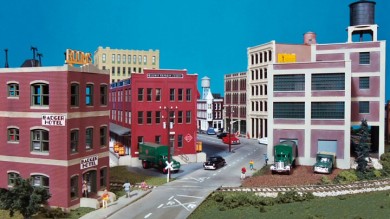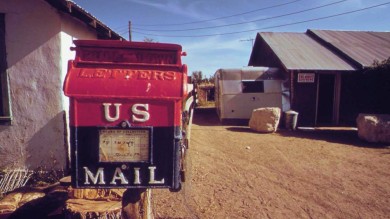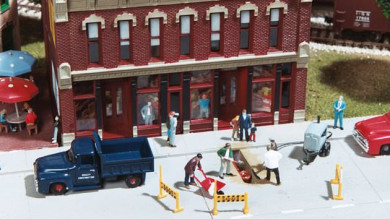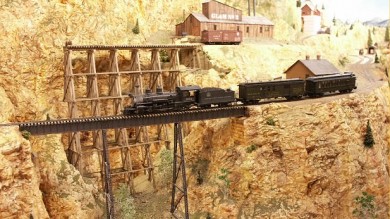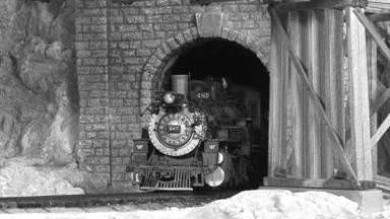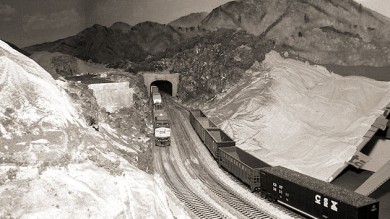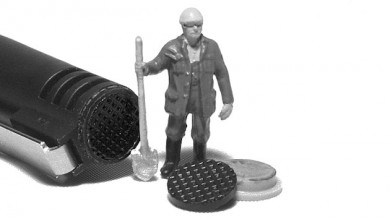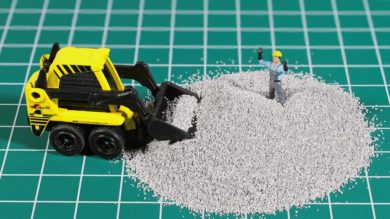Easy Trees for the Backdrop
For those with limited painting skills, applying trees to the backdrop to transition from three-dimensional to two-dimensional scenery can be daunting. With the judicious application of scissors to sponges, simple shapes may be created to allow you to stamp trees onto your backdrop....
Read MoreFeb 15, 2010
Comments are off
Building City Streets Using Walthers Cornerstone Street Systems
Techniques for modeling concrete, brick and asphalt streets, and concrete grade crossings, on your model railroad layout with the Walthers Cornerstone street system....
Read MoreGetting Down to Details – Mailboxes
Some years ago I wrote a brief piece for The RPO relating information I had picked up at a national convention. It focused on making sure that details on the layout fit the time frame modeled, and gave approximate times that hay stacks went from stack or square bales to rolled, or whe...
Read MoreTips and Techniques for Painting Figures
The figures on the History Museum project are from a kit of 120 unpainted figures. Figures can be purchased already painted, but are often very costly ($1 to $3 each). I prefer to purchase the unpainted, which come in several kits: trades people, passengers, drivers, pedestrians, etc....
Read MoreThe Colorful Scenery of the C&RM Railroad
Well, are you getting “snow blind” yet from all those white rocks that you have made since my article about rock casting? Don’t you think it is about time to add some color? Adding a little color will bring the rock castings to life. The colors add shadows and highli...
Read MoreThe Light at the End of the Tunnel
Article & photo by Tom Troughton, MMR How many times have you entered a fellow model railroader’s train room to be awe struck at the magnificent layout before your eyes. There’re several hundred feet of meticulously constructed hand laid track, on tie plates even, trac...
Read MoreHardshell In A Hurry
Photo by Kevin Hampton If you’re using Hydrocal as the base shell for scenery, there’s a quick way to cover a large area in a hurry. After putting down whatever you use to set the basic elevations for scenery, use Hydrocal soaked cloth instead of paper towels, newspaper or paper bags....
Read MoreSep 04, 1998
Comments are off
More Cheap Tricks – Manhole Covers
The cap end of Faber fine Uni-Ball pens were obviously designed as an HO or S manhole cover. A new X-Acto knife will easily cut off the cover (cut flush with the lip on the side, it’s almost like they provided a cutting guide!). The photo by Richard Schumacher shows the pen, a cut off...
Read MoreMore Scenery Tips – Supporting Hard Shell Scenery
There are many different methods for supporting hard shell scenery. Cardboard strips, chicken and screen wire, rolled up newspapers and Styrofoam. There are countless approaches to creating the initial support for the hard shell. I have discovered one which I found easy, clean and saf...
Read MoreMore Cheap Tricks – Styrene Concrete
Making styrene look like concrete is much easier than it sounds! On my layout, the “JDS&E”, I decided to use sheet styrene for my service platforms in the engine facility. I first scored the sheet into 12 foot squares using a hobby knife. I then laid the sheet flat and block sande...
Read MoreMore Scenery Tips – Rock Casting Methods
Have you ever looked at someone’s layout and wondered how they did all the rock castings? There are basically two methods, dry and wet. The dry method allows the modeler to mix large batches of plaster at a time. Have several molds ready and pour the plaster into molds until your supp...
Read MoreMore Cheap Tricks – Cheap Killer Ballast
Low Cost Tips to Improve Your Railroad Modeling Photo by Richard Schumacher Trackwork is the most visible representation of your model railroad. It does not matter if the train is even on the track, the track is still there for all critical eyes to critique. It defines from where your...
Read More12
Copyright © 2020 Gateway Division NMRA. All rights reserved. | Website Info | Legal Notices

